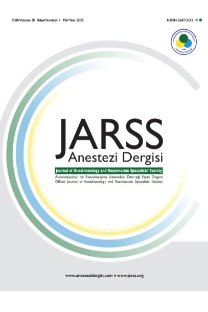Sevofluran ve propofol indüksiyonlarının rokuronyumun nöromuskuler bloğuna etkisi
Nöromüsküler blokaj, Propofol, Laringoskopi, Entübasyon, Ses telleri, Alfentanil
Effects of inductions with sevoflurane and propofol on the neuromuscular block of rocuronium
Neuromuscular Blockade, Propofol, Laryngoscopy, Intubation, Vocal Cords, Alfentanil,
___
- 1. Hall JE. Stewart JIM, Harmer M. Single-breath inhalation induction of scvoflurane anaesthesia with and without nitrous oxide: a feasibility study in adults and comparison with an intravenous bolus of propofol. Anaesthesia 1997; 52: 410-15.
- 2. McCourt KC, Salmela L. Carroll M. Kerr CN. Mirachur RK, Olkkola KT. Comparison of rocuronium and suxamelhonium for use during rapid sequence induction of anaesthesia. Br J Anaesth 1997; 79: 134P
- 3. Cooper R, Mirachur RK. Clarke RSJ. Boules Z. Comparison of intuhaiing conditions after administration of Org 9426 (rocuronium) and suxamethonium. Br J Anaesth 1992:69: 269-73
- 4. Hans P, Brichant JF. Hubert B, Dewandre PY, Lamy M. Influence of induction of anaesthesia on intubating conditions one minute after rocuronium administration: comparison of ketamine and thiopentone. Anaesthesia 1999; 54: 276-9.
- 5. Baraka AS. Sayyid SS, Assaf BA.Thiopental-rocuronium versus ketamine-rocuronium for rapid-sequence intubation in parturients undergoing cesarean section. Anesth Analg 1997: 84: 1104-7.
- 6. Dobson AP. Mc.Cluskey A, Meakin G, Baker RD. Effective time lo satisfactory intubation conditions after administration of rocuronium in adults. Comparison of propofol and thiopentone for rapid sequence induction of anaesthesia. Anaesthesia 1994; 54: 172-6
- 7. Skinner HJ. Biswas A, Mahajan RP. Evaluation of intubating conditions with rocuronium and either propofol or etomidate for rapid sequence induction. Anaesthesia 1998; 53: 702-6
- 8. McKeting K, Bali IM, Dundee JW. The effects of thipentone and propofol on upper airway integrity. Anaesthesia 1988; 43: 638-40
- 9. Sparr HJ, Giesinger S, Ulmer H, Hollenstein-Zacke M, Luger TJ. Influence of induction technique on intubating conditions alter rncuronium in adults: comparison with rapid sequence induciion using thipentone and suxamethonium. Br J Anaesth 1996; 77: 339-42
- 10.Fuchs-Buder T, Sparr HJ, Ziegcnfup. Thiopental or etomidate for rapid sequence induction with rocuronium. Br J Anaesth 1998;8O: 504-6
- 11. Chetty MS. Pollard BJ, Wilson A. Healy TEJ. Rocuronium bromide in dental case anaesthesia-a comparison with atracurium and vecuronium. Anaesth Intens Care 1996; 24: 34-41
- 12. Barclay K, Eggers K, Asai T. Low -dose rocuronium improves conditions for tracheal intubation after induction of anaesthesia with propofol and alfentanil. Br J Anaesth 1997: 78: 92-4
- 13. Prien T, Zahn P, Menges M, Brussel T. 1 ED90 dose of rocuronium bromide: tracheal intubation conditions and time-course of action. Eur J Anaesth 1995; 11 (Suppl.): 85-90
- 14. Hall Je, Oldham TA, Stewart JIM, Harmer M. Comparison between halotane and sevoflurane for adult vital capacity induction. Br J Anaesth 1997; 79: 285-8
- 15. Sloan MH. Conard PF, Karsunsky PK, Gross JB. Sevoflurane versus isoflurane: induction and recovery characteristic with single breath inhaled inductions of anesthesia. Anesth Analg 1996;82:528-32
- 16. Lowry D, Mirachur RK, Me Carthy GJ, Carroll MT, Me Coun KC. Neuromuscular effects of rocuronium during sevoflurane, isoflurane and intravenous anesthesia. Anesth Analg 1998: 87: 936-40
- 17. Lowry DW, Carroll MT, Mirachur RK, Hayes A, Hughes D, O'Hare R. Comparison of sevoflurane and propofol with rocuronium for modified rapid-sequence induction of anaesthesia. Anaesthesia 1999; 54: 247-52
- ISSN: 1300-0578
- Yayın Aralığı: 4
- Başlangıç: 1993
- Yayıncı: Betül Kartal
Postoperatif titremeyi önlemede oral klonidin premedikasyonunun etkisi
Epidural midazolamın sedasyon, analjezi ve hemodinami üzerine etkisi
Betül YİĞİTBAŞI, Ruhiye REİSLİ, Eyüp HORASANLI, Semra DEMİRBİLEK, Beyazıt DİKMEN, Orhan KANBAK, Nermin GÖĞÜŞ
Rokuronyum ile oluşturulan nöromusküler blokta efedrinin etkisi
Yasemin GÜNEŞ, Hakkı ÜNLÜGENÇ, Nurcan DORUK, Selim DEMİR, ABDULKADİR GEYLAN IŞIK
Transüretral prostatektomilerde etanol monitorizasyonu
Nurten BAKAN, ENDER GEDİK, Ahmet ŞALVARCI, M. Özcan ERSOY, Semih ÖZKAN, Saim YOLOĞLU
Sevofluran ve propofol indüksiyonlarının rokuronyumun nöromuskuler bloğuna etkisi
Selma OĞUZ, A. Tülin AKILLI, Rüstem ALBAYRAK, Nihal KADIOĞULLARI
Farklı entübasyon değerlendirme testlerinin zor entübasyon ile ilişkisi
Üst solunum yolu obstrüksiyonunu takiben gelişen nonkardiyojenik pulmoner ödem (Olgu sunumu)
Sibel SAYDAM, Feray GÜRSOY, Nurten BAKAN, NURÇİN GÜLHAŞ
Ayda TÜRKÖZ, Ahmet KÖROĞLU, Rıza TÜRKÖZ, M. Özcan ERSOY
Mezoatrial şant uygulanan Budd-Chiari sendromu olgusunda anestezik yaklaşım
Meltem ÜNSAL, Yeşim ATEŞ, Ali YILMAZ, Birsen SAYGIN
Fatiş ALTINTAŞ, Pervin BOZKURT, Şener DEMİROLUK, Ebru ATİLLA, Güner KAYA
